Bill Young/Colleen Thomas & Co. February 22 & 23
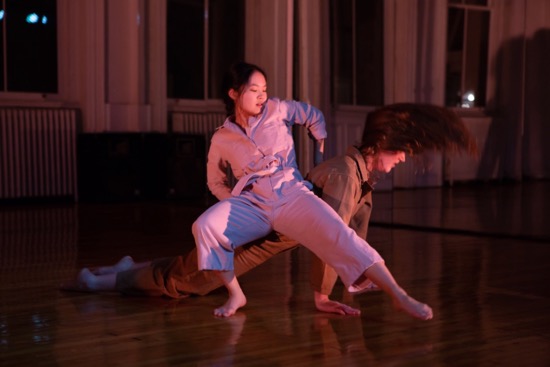
I’m sitting in Bill Young and Colleen Thomas’s loft waiting for the rest of the audience to straggle in, greet friends, maybe pick up something to drink, and settle down for the program of dance in LIT No. 19 (Loft into Theater). Memories assail me, specifically those filed away under “good old days in NYC,” when choreographers secured low-rent lofts and—legally or sneakily— moved in and turned them into part-time performance sites. (During the earliest of those days, you could also enter an Italian restaurant in Greenwich Village that hadn’t yet secured a liquor license, ask for a “special coke,” and be brought a glass of red wine.)
I’ve taken off my coat, turned off my cell phone, and chatted with the people on either side of me (one of whom I haven’t seen in quite a while), who are also talking to each other across me. To get there, we’ve all walked along a considerably gentrified Grand Street, most of its shops closed at this hour; noted the discreet “do not buzz, door open” type of sign at #100; climbed a long staircase under a peeling ceiling; checked in at a small table; and waited in the crowd massing on the steps for Young to open the door and let us in. I venture a small, contented, only-in-New-York sigh.
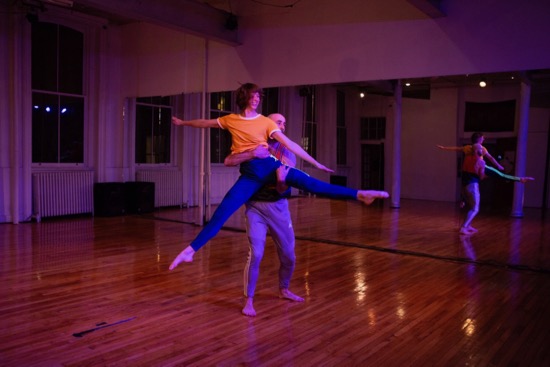
Anyone unfamiliar with the expert performers involved has only to consult the program to learn how many well-known choreographers they’ve worked with. Two of the works are by Thomas; Young choreographed four of them. Four are duets, one is a solo, and one a trio. The intimate setting also enables us to see these from two perspectives. The wall to our right is mirrored; a trio can become a sextet, a duet a foursome. The lighting that Joe Levasseur has designed with remarkably few instruments alters the space in wonderfully sensitive ways.
The wood floor —golden brown, unmarred, and glowing—plays a starring role. It all but invites a dancer to rest on it. Or fall to it, roll across it, and spring back up and into the arms of a colleague in one seamless maneuver.
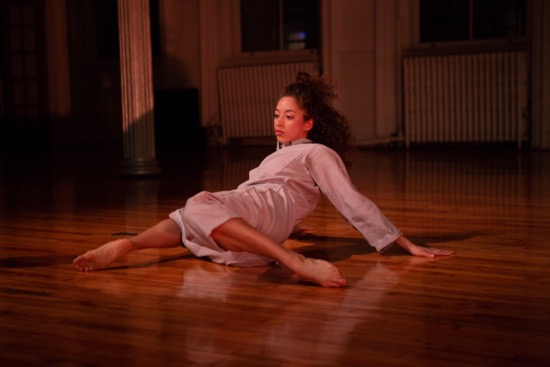
Thomas, who is on the faculty of Barnard College’s Dance Department, may have cast some of her former students in Diane. Still, which she dedicates to “you who made me dance even when I couldn’t walk.” Nadia Halim, Sadi Mosko, and Rochelle Jamila Wilbun perform this quiet trio while Jo Morris accompanies them intermittently on electrified guitar (her own music and that of the Bee Gees). There are degrees of speech in the piece. Wilbun speaks of chakras and of a crystal held to the eye (I hear the words but don’t quite process them). Halim speaks of her Chinese family, mostly in words we’re not meant to hear. Mosko only briefly mouths the words of the song to which we’re listening.
I used the word “quiet,” but Thomas’s choreography (on which the dancers collaborated) isn’t docile; it’s full of big, flung steps and moments of suspension before a noiseless fall. It’s also structurally satisfying—that is, movements repeat in new configurations, whether performed in unison by all three women or just two. This kind of repetition can make you feel as if you the watcher are considering the dance from different viewpoints.
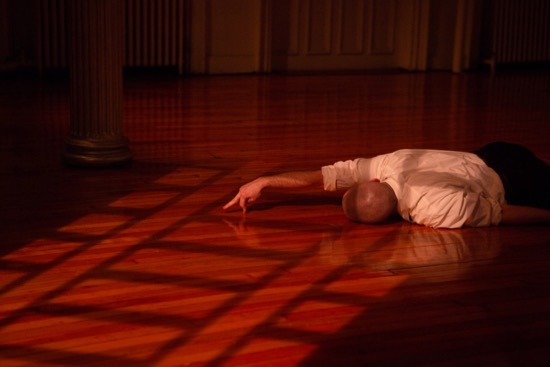
rI first saw Damsel in 2011. Thomas has revived the solo for Peter Chamberlin, and he performs it excellently to the ¾ strains of “Que Sera Sera” (whatever will be will be). Sung in English and often submerged in chaotic muttering, muted cacophony, and vibrating static, it begins with a question: “When I was just a little girl, I asked my mother, “what will I be?” Chamberlin begins by tiptoeing along an unseen snaking path. Attached to one side of his shirt is a pink fabric flower too big to be a boutonniere. I feel as if he’s making his way through a gale of some kind. The word “damsel,” seldom heard these days, hints at ladylike purity and vulnerability. Levasseur’s lighting projects a lattice onto one side of the floor, and, in a quiet moment, Chamberlin lies down and walks two fingers across it. Later he sucks his thumb unobtrusively as he dances. In the end, he is supine by the lattice, and, lying on his chest is a big bunch of white cord that he has picked up; his feet are working at making tiny steps, but, prostrate as he is, he never travels from his spot. It’s curious to watch something this enigmatic happening so close to you that you never try to probe its collaged realities. Only afterward do I think about a possible backward voyage to the womb.
Young’s four duets all create images of intimacy that are sensitive even when contentious. In AngelCrash, set to a score by Mio Morales, Oluwadamilare Ayorinde and Jamie Scott dance the same steps separately and then, holding hands, together. Rumbling sounds and harsh ones, plus a high, muffled voice calling out, create an unstable environment. Dancing not only with their mirrored images and their shadows thrown on another wall, the two also embrace tightly—heads on each other’s shoulders—and, taking small steps, turn without travelling, affixed to the spot on which they stand.
Their lifts are remarkable, not like the ones we’re familiar with. You’d never expect that one body could balance on another in such ways. I find myself thinking of catapults—the way Scott, pulling against Ayorinde’s clasped one hand, can suddenly be sprung onto her partner and cling there as if their bodies are magnetically attracted. Scott can, briefly, lift Ayorinde off the ground too. In the end, though, he is alone.
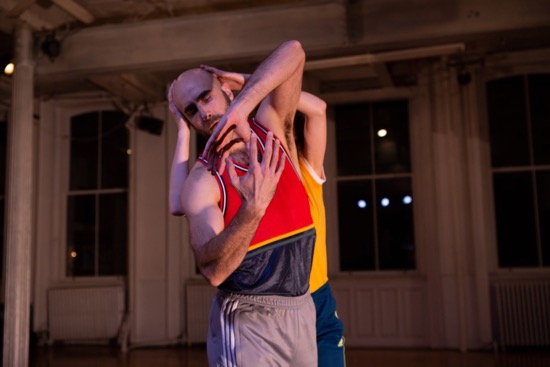
Team II is more competitive. Lindsey Jones moves Burr Johnson where she wants him to be by placing both hands on his bald head and gently turning him before she sets him leaping; she also takes hold of a few hairs on his short beard and gives them quick tug. The two are good at collaborating, and I love the attentiveness with which they regard each other. Separated by a couple of feet and leaning together, they manage, thus slanted, to walk along together. They also have a small movement debate about which knee to lift high when. Some of the things they embark on are extremely daring. She falls forward as straight as a toppling tree; he, behind her, catches her in the nick of time. They are equal in strength however; she lifts him as if he were a baby; then he drags her along; then she lifts him again. They leave the room, as you might expect, together.
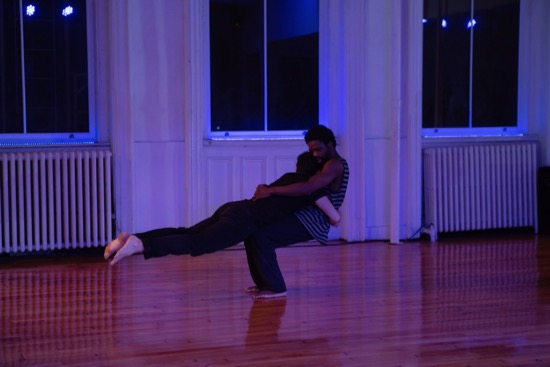
Strings of tiny blue light bulbs drape the windows outside the lofts, and Morales’s score includes sounds of clapping and a guitar with Spanish inflections when Darrin Wright and Ayorinde perform Young’s Doubles. They, more evenly matched than Jones and Johnson, are, if anything, more athletic. These two men can cover ground in amiable unison, but one of them can be levered up to stand on the other’s lifted thigh, and in a startling move, one guy (I forget which) lifts the other, charges at the mirror, and make his partner’s feet run up it, before swinging him into something else. They’re not all muscle though; one briefly lays his head in the other’s lap. And they walk out together, as if planning to continue their games in another room.
Wright transforms himself into a stagehand in preparation for Off (another remade work that I first saw in 2011 with a different cast). He blocks three of the windows by fitting white panels into them. In a few seconds, we’ll understand why. This is the most intimate and sensual of the four duets. Lauren Ferguson, who’s been standing quietly at one side, removes her overcoat and drops it on the floor. Gary Champi is waiting for her. So is Levasseur, holding a spotlight and prepared to follow the couple wherever they go. So is Young, who trains a small movie camera on the scene. We are, then, to be voyeurs, able to see Ferguson and Champi from several perspectives: the two, their mirrored images, and closeups of them projected from the camera onto the window panels.
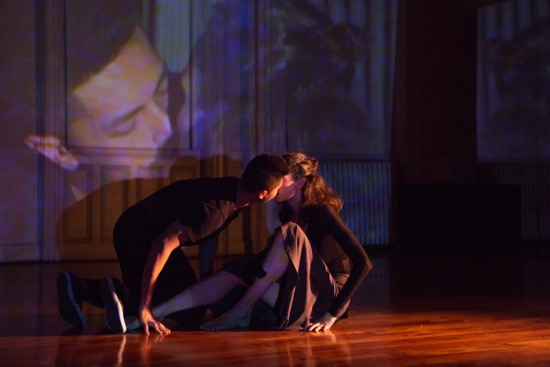
At first, we tend to focus on a kiss, or a near kiss. The two dancers slowly, smoothly twist together and unwind, change levels, change directions, all the while each keeping his/her lips only an inch or two away from the other’s. (Imagine please, how difficult this may be to do.) All is not gentle, however. After a few minutes, Champi takes his shirt off and tosses it aside. Ferguson bites his back, and he yells “Ow!” We hear that protest a couple more times. Later they laugh silently.
Once they’re done with kissing, they find more complicated, more awkward, but evidently fulfilling ways of uniting. Picture this: He walks slowly on wide-apart knees, his body erect, while she stands on his heels (!), both of them spreading their arms like wings. As they progress away from us toward the camera, they resemble an unknown species of beast with unusual mating habits. Remember too that we’re quite close to the dancers and that we see what the camera sees—those heads in their close dance and then a more curious joining of their bodies. Off is (how can I describe it?) erotic yet not erotic. Engrossing for sure.
Then the evening’s over. Or not. The woman to my left gives a satisfied sigh and conveys her enjoyment to me. I nod. But the spectators aren’t in a hurry to leave and have been informed that that’s okay. They chat, drink, slowly get their coats on. When I hit the sidewalk, only a couple of other people have emerged into the chilly night. We speak briefly and go our separate ways. Only in New York. . . .

Your taste of nostalgia for non-gentrified NY touched me too. Even being in the audience felt daring. For instance, Bruce Andrews and I were sitting on the edge on a riser in the back row and if either of us had pushed our chairs back by accident we would have hit the floor and most likely would have qualified for “if you have been injured by anything” lawyers. I share your enthusiasm for especially the partnering in the work and I also thought Chamberlain’s dancing was special and articulate. Lindsey dances in my work and she never fails to charm while being so risky. Thanks Deborah!
I thoroughly enjoyed this adventure in dance in New York. I wish I could have been there. I think I will grab a ‘special coke’ and read it again!
“Only in New York”? I’m afraid I must beg to differ, for this atmospheric, elegantly written, highly knowledgeable review filled me for nostalgia for a lost space in Portland (the one that’s 3000 miles away from NY, not the one north of my home town) called Conduit, where I damn near did fall backwards off a bleacher seat about 15 years ago.
You are a camera!